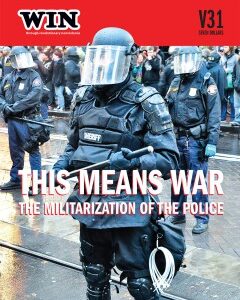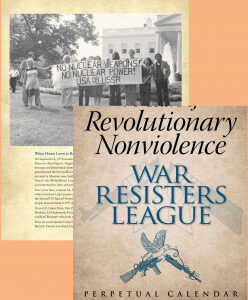WIN Letter
A Fierce Hope Carries Us
Suddenly, there’s optimism. The rising movements have seen setbacks: the betrayal of much of Egypt’s spring, evictions of occupiers everywhere. Yet the movements appear to be continuing and, on the whole, to react to those setbacks as challenges, not defeats. If the risings circled the globe like a virus, the optimism and energy that suffused them have persisted even when the risings subsided temporarily.
That optimism, that energy—and the nonviolence that characterized so much of the new resistance—permeate this issue of WIN, which is bursting at the seams with all three. Certainly the “#occupy/Decolonize” section is a testament to what Isabell Moore describes in “Why I Occupy” as the “fierce hope” that “gave people the bravery to take the risks that [bring] about change.” Felicity Palma’s “Picturing Occupy Wall Street” shows genuine jubilance, and there is deep optimism in Isham Christie’s look at the global solidarity between and among the Occupy movements, Rosalie Riegle’s description of preparations to confront the NATO war makers next month in Chicago, and Matt Meyer’s picture of anti-racist organizing in Brooklyn. There are warnings—two—about the possibilities of elitism and burnout facing the movement, yet they, too, are hopeful, in this case that those dangers can be averted, that inclusivity can become the model, that people can keep on keeping on for the long haul. And that WRL is feeling the energy shows in the more-news-than-usual WRL news and even in the expansive letters section.
If you still doubt that there’s something new and different in the air, just note the contrast between the tone of “#occupy/Decolonize” and the special section of Radical Reviews, which covers a lot of historical ground. The reviews cover the long and painful account of economic exploitation laid out in Debt: The First 5,000 Years, an examination of the terrible futility of the First World War (To End All Wars), a look back at a classic French film about World War II (Les Jeux Interdits/Forbidden Games); three books about 1960s activists (Hillbilly Nationalists, Urban Race Rebels, and Black Power: Community Organizing in Radical Times; David Gilbert’s Love and Struggle: My Life in SDS, the Weather Underground, and Beyond; and Blood on the Tracks: The Life and Times of S. Brian Willson); and another look back at a classic 1976 anarchist novel, Letters of Insurgents. None shows anything like today’s #occupy movement. That just may be because nothing quite like it has ever happened.

 WIN Winter 2015 - This Means War: The Militarization of the Police
WIN Winter 2015 - This Means War: The Militarization of the Police  WRL Perpetual Calendar
WRL Perpetual Calendar